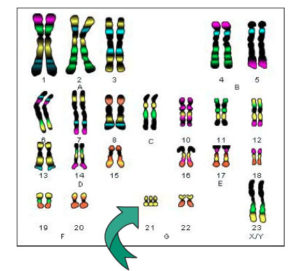
What is it?
Down syndrome is the most commonly occurring chromosomal condition. It happens when some or all of a person’s cells have an extra full or partial copy of chromosome 21. This extra genetic material changes how a fetus develops and causes the characteristics associated with Down syndrome.
There are three basic types of Down syndrome: trisomy 21, translocation, and mosaicism.
Trisomy 21
Most people who have Down syndrome have an entire extra chromosome (47 instead of 46) in every cell in their body. This type of Down syndrome is not genetically inherited.
Translocation
A few people with Down syndrome have a type called translocation. This type of Down syndrome may be passed down through families (inherited), but most cases are chance events. Although the total number of chromosomes is the typical 46, a part of chromosome 21 breaks off, attaches to another chromosome, and produces the signs and features of Down syndrome.
Mosaicism
A few people with Down syndrome have a type called mosaicism. This type is not inherited. Mosaicism results when some cells in the body develop with the typical 46 chromosomes, while others have 47 that include an extra copy of all or part of Chromosome 21. Individuals with mosaicism sometimes exhibit fewer of the characteristics of Down syndrome than those with translocation or trisomy 21.
cells in the body develop with the typical 46 chromosomes, while others have 47 that include an extra copy of all or part of Chromosome 21. Individuals with mosaicism sometimes exhibit fewer of the characteristics of Down syndrome than those with translocation or trisomy 21.
The most common physical traits are low muscle tone, small stature, an upward slant to the eyes and a single deep crease across the center of the palm. However, the only thing people with Down syndrome have in common with one another is the diagnosis of Down syndrome; Down syndrome’s extra genetic material plays out in each individual differently. These traits, which also occur in the general population, may not be present in a person with Down syndrome at all.
All people with Down syndrome experience cognitive delays, but the effect is usually mild to moderate and is not indicative of the many strengths and talents that each individual possesses.
Down syndrome occurs in people of all races and economic levels. The incidence of births of children with Down syndrome increases with the age of the mother, but, because younger women have a higher fertility rate, 80% of children with Down syndrome are born to women under the age of 35.
Quality of Life
Quality educational programs, a stimulating home environment, good health care, and positive support from family, friends and the community enable people with Down syndrome to develop their full potential and lead fulfilling lives. People with Down syndrome attend school and work. They make friends, socialize, date, form on-going relationships and marry. They participate in decisions that affect them, and they contribute to society.
Medical Concerns
Most people with Down syndrome lead healthy lives. Many of the medical conditions for which they are at increased risk – congenital heart defects, respiratory and hearing problems, Alzheimer’s disease, childhood leukemia and thyroid conditions – are now treatable. Life expectancy has increased dramatically in recent decades – from only 25 years in 1983 to 60 years or more today. Researchers are making great strides in identifying the genes on Chromosome 21 that cause the characteristics of Down syndrome. Many believe that it will be possible to improve, correct or prevent many of the problems associated with Down syndrome in the future.
Speaking about Down Syndrome
People with Down syndrome should always be referred to as people first. Instead of “a Down syndrome child,” one should say, “a child with Down syndrome.” Also avoid “Down’s child” and describing the condition as “Down’s,” as in, “He has Down’s.” Down syndrome is a condition or a syndrome, not a disease. People “have” Down syndrome, they do not “suffer from” it and are not “afflicted by” it. While it is clinically acceptable to say “mental retardation,” you should use the more socially acceptable term “intellectual disability. DS ACT and many other organizations strongly condemn the use of the word “retarded” in any derogatory context. Using this word is hurtful and suggests that people with disabilities are not competent.
The preferred spelling is Down syndrome, rather than Down’s syndrome. Many dictionaries contain both spellings (with or without an apostrophe s), but the preferred usage in the United States is Down syndrome. This is because an “apostrophe s” connotes ownership or possession. Down syndrome is named for the English physician, John Langdon Down, who characterized the condition, but did not have it. The AP Stylebook recommends using “Down syndrome,” as well.

 Connecting Families
Connecting Families